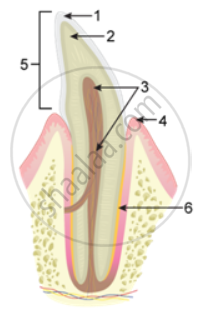Advertisements
Advertisements
Question
Study the following dental formula and then answer the question that follow:
`"i" 3/4 "c" 0/0 "pm" 0/1 "m" 1/1`
Name an animal possessing such a dentition.
Solution
The given dentition is likely to be present in any herbivore such as deer.
APPEARS IN
RELATED QUESTIONS
The gall bladder temporarily stores bile.
When a person puts food in his mouth, then teeth cut it into small pieces, chew and grind it. The glands A in the mouth secrete a substance B which is mixed with the food by tongue. The substance B contains an enzyme C which starts the digestion of food in the mouth. The slightly digested food from the mouth goes down a tube D. The special type of movements E in the walls of tube D push the food into stomach for further digestion. The stomach wall secretes gastric juice containing three substance F, G and H. One of the functions of F is to kill bacteria which may enter the stomach with food. The substance G protects the inside layer of stomach from the damaging effect of substance F whereas substance H is and enzyme for digestion. The partially digested food then enters into small intestine for further digestion.
(a) What is (i) gland A (ii) substance B, and (iii) enzyme C?
(b) Name the tube D.
(c) What is the movement E known as?
(d) What are (i) F (ii) G, and (iii) H?
Gastric juice contains
Study the diagram given below and then answer the question that follows:

Give the total number of the type of tooth mentioned in '1' above, in the mouth of an adult and state its function.
Put a tick (✓) against the most appropriate alternative in the following statement.
The teeth which help in tearing the food are the:
Name the three regions of the large intestine.
State one difference in nutrition: Parasite and Saprophyte
Name the types of teeth in human with functions.
In which part of the alimentary canal food is finally digested?
Read the following passage carefully and answer the questions that follow it. Bile juice is stored in a sac called, the gall bladder, located near its organ of secretion, the liver. The gall bladder releases the bile juice into the small intestine whenever food reaches there. Though bile juice is devoid of any digestive enzymes, it is required for the digestion of fats. The fats cannot be digested easily because they are insoluble in water and are present as large globules. Bile juice breaks down big fat droplets into smaller droplets. These are then easily digested by the enzymes released from the pancreas.
- Which organ secretes the bile juice?
- Why is digestion of fats difficult as compared to that of other nutrients?
- How does bile juice help in the digestion of fat?
- Where is the digestion of fat completed?
- Does bile juice digest fat completely?
